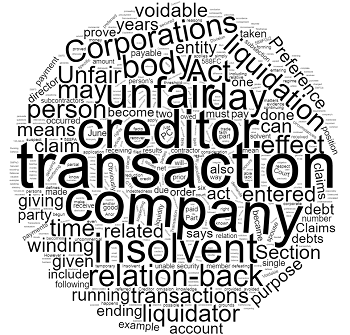Table of Contents
Toggle Unfair preference claims are one of the types of voidable transactions in company insolvency and is outlined at section 588FA of the Corporations Act 2001 (CTH) (“the Corporations Act”).
Unfair preference claims are one of the types of voidable transactions in company insolvency and is outlined at section 588FA of the Corporations Act 2001 (CTH) (“the Corporations Act”).
An unfair preference occurs when:
- There is a transaction between the company and an unsecured creditor; and
- The transaction occurred while the company was insolvent; and
- The transaction results in the creditor receiving more than the creditor would receive from the company if the creditor were to prove for the debt in a winding up of the company.
If this happens, then a liquidator may be entitled to recover those funds from the creditor.
There are a number of defences and exceptions to the above which may mean that a creditor does not have to repay hard-earned monies to the liquidator.
In this article our experienced insolvency lawyers explain in detail unfair preference claims under the voidable transaction regime and details the possible defences and exceptions to unfair preference claims.
If you have been contacted by a liquidator in relation to unfair preference claims you should contact an insolvency lawyer as soon as possible to attempt to defend the liquidator’s demand for money
What are Voidable Transactions?
A voidable transaction in company insolvency is a transaction entered into by the company and a third-party which can be avoided and recovered by the liquidator of the company in liquidation.
Voidable transactions can include:
- 588FA – Unfair preferences;
- 588FB – Uncommercial transactions;
- 588FC – Insolvent transactions;
- 588FD – Unfair loans to a company; and
- 588FDA – Unreasonable director-related transactions.
Section 588FE of the Corporations Act outlines the criteria for a transaction able to be avoided by the liquidator.
- There must be a transaction; and
- The transaction must be an insolvent transaction; and
- It was entered into, or an act was done for the purpose of giving effect to it:
- During the 6 months ending on the relation-back day; or
- It is also an uncommercial transaction – 2 years ending on the relation-back day; or
- It is also a related entity of the company – 4 years ending on the relation-back day; or
- The company became a party to the transaction for the purpose of defeating, delaying, or interfering with, the rights of any or all of its creditors – 10 years ending on the relation-back day.
Then, each of the voidable transactions have their own specific requirements.
What is a Transaction?
Section 9 of the Corporations Act defines a transaction to mean:
“transaction” … means a transaction to which the body is a party, for example (but without limitation):
(a) a conveyance, transfer or other disposition by the body of property of the body; and
(b) a security interest granted by the body in its property (including a security interest in the body’s PPSA retention of title property); and
(c) a guarantee given by the body; and
(d) a payment made by the body; and
(e) an obligation incurred by the body; and
(f) a release or waiver by the body; and
(g) a loan to the body;
and includes such a transaction that has been completed or given effect to, or that has terminated.
Obviously, this is just a list of examples and section 9 explicitly does not limit the scope of what a transaction can be.
What is an Insolvent Transaction?
Section 95A of the of the Corporations Act defines solvent and insolvent to mean:
(1) A person is solvent if, and only if, the person is able to pay all the person’s debts, as and when they become due and payable.
(2) A person who is not solvent is insolvent.
This essentially means that a company that is unable to pay its debts as and when they become due and payable is insolvent.
Care should be taken however to distinguish a temporary lack of liquidity with insolvency. In Sandell v Porter (1966) 115 CLR 666 the High Court said:
The conclusion of insolvency ought to be clear from a consideration of the debtor’s financial position in its entirety and generally speaking ought not to be drawn simply from evidence of a temporary lack of liquidity.
Section 9 of the Corporations Act says:
“insolvent transaction” has the meaning given by section 588FC.
Section 588FC of the Corporations Act says:
A transaction of a company is an insolvent transaction of the company if, and only if, it is an unfair preference given by the company, or an uncommercial transaction of the company, and:
(a) any of the following happens at a time when the company is insolvent:
(i) the transaction is entered into; or
(ii) an act is done, or an omission is made, for the purpose of giving effect to the transaction; or
(b) the company becomes insolvent because of, or because of matters including:
(i) entering into the transaction; or
(ii) a person doing an act, or making an omission, for the purpose of giving effect to the transaction.
So, an insolvent transaction is a transaction entered into, or an act is done giving effect to a transaction, at a time when a company is unable to pay its debts as and when they become due and payable.
Or the company becomes unable to pay its debts as and when they become due and payable because the transaction was entered into, or because of the act being done giving effect to a transaction.
So that is a voidable transaction. This article will focus on Unfair Preference Claims.
What are Unfair Preference Claims?
An unfair preference means that because one (1) creditor has been paid more than if it had to prove its debt in the liquidation, while other creditors have not been paid, that creditor will be preferred.
Section 588FA(1) of the Corporations Act 2001 (CTH) says:
(1) A transaction is an unfair preference given by a company to a creditor of the company if, and only if:
(a) the company and the creditor are parties to the transaction (even if someone else is also a party); and
(b) the transaction results in the creditor receiving from the company, in respect of an unsecured debt that the company owes to the creditor, more than the creditor would receive from the company in respect of the debt if the transaction were set aside and the creditor were to prove for the debt in a winding up of the company;
even if the transaction is entered into, is given effect to, or is required to be given effect to, because of an order of an Australian court or a direction by an agency.
As previously outlined above, an unfair preference occurs when:
- There is a transaction between the company and an unsecured creditor; and
- The transaction occurred while the company was insolvent; and
- The transaction results in the creditor receiving more than the creditor would receive from the company if the creditor were to prove for the debt in a winding up of the company.
In Ashala Model Agency Pty Ltd (in liq) & Anor v Featherstone & Anor [2016] QSC 121 Jackson J said at [139]:
… an unfair preference turns on the result or effect of the transaction in relation to an unsecured debt owed to the creditor, by comparing what the creditor received from the company with what the creditor would have received on a winding up (in a pari passu distribution of the available assets to the unsecured creditors in accordance with the statutory priorities).
Timeframes for Unfair Preference Claims
The liquidator must prove that the insolvent transaction was entered into, or an act was done for the purpose of giving effect to it during the 6 months ending on the relation-back day.
Alternatively, if the preferred entity is also a related entity of the company, then the insolvent transaction was entered into, or an act was done for the purpose of giving effect to it during the 4 years ending on the relation-back day.
Lastly, if the company became a party to the transaction for the purpose of defeating, delaying, or interfering with, the rights of any or all of its creditors then the insolvent transaction was entered into, or an act was done for the purpose of giving effect to it during the 10 years ending on the relation-back day.
This raises some further questions, namely:
- What is the relation-back day? and
- What is a related entity?
What is the Relation Back Day?
The relation-back day is the day that either the winding up application was filed; or the day on which one of the other days outlined at 513B of the Corporations Act or 513C of the Corporations Act.
Section 9 of the Corporations Act says:
“relation-back day” has the meaning given by section 91.
Section 91 of the Corporations Act has a table which basically says the relation-back day is (depending on the circumstances):
- The date of the filing of the winding up application; or
- The date the company resolves that it be wound up voluntarily; or
- The date that the deed of company arrangement was executed.
So, if a creditor applies to a Court for an order winding up the debtor company on 20 June, and the company is subsequently wound-up, then the relation-back day is 20 June.
This means that for a transaction from an unrelated entity to be a voidable transaction, it must have occurred six (6) months prior to 20 June.
This means that for a transaction from a related entity to be a voidable transaction, it must have occurred two (2) years prior to 20 June.
What is a Related Entity?
A related entity is defined at section 9 of the Corporations Act. The most common include:
- A director or member of the body or of a related body corporate; and/or
- A relative of such a director or member; and/or
- A relative of a spouse of such a director or member; and/or
- A body corporate that is related to the first-mentioned body.
So, a transaction to a related entity could include a transaction from the company to a director, a wife of a director, or a related company of the company in liquidation.
Example of an Unfair Preference in Liquidation
A typical example of an unfair preference in liquidation is:
- A building contractor engages 3 subcontractors to conduct work;
- The contractor pays one of the subcontractors, but not the other two;
- The contractor goes into liquidation two (2) months later;
- The two unpaid contractors become unsecured creditors in the liquidation;
- The money paid to the single subcontractor may be an unfair preference and recoverable by the liquidator.
The idea is to recover as much as possible into the fund to pay all creditors of the company in liquidation. This is understandable, but not nice for small subcontractors who need the money.
However, there are a number of defences and exceptions to unfair preference claims.
Defences to Unfair Preference Claims
There are defences to unfair preference claims. They include:
- The party entered into the transaction in good faith; and
- At the time of entering into the transaction a reasonable creditor did not know, or ought not to suspect that the company was insolvent.
Section 588FG of the Corporations Act prescribes transaction which are not voidable as against certain persons. As against a creditor, 588FG(2) says:
(2) A court is not to make under section 588FF an order materially prejudicing a right or interest of a person if the transaction is not an unfair loan to the company, or an unreasonable director-related transaction of the company, and it is proved that:
(a) the person became a party to the transaction in good faith; and
(b) at the time when the person became such a party:
(i) the person had no reasonable grounds for suspecting that the company was insolvent at that time or would become insolvent as mentioned in paragraph 588FC(b); and
(ii) a reasonable person in the person’s circumstances would have had no such grounds for so suspecting; and
(c) the person has provided valuable consideration under the transaction or has changed his, her or its position in reliance on the transaction.
The most important of the above is proving that a creditor did not know, or ought to have known, that the company in liquidation was insolvent at the time of the transaction.
The Suspicion of Insolvency
Obviously, the wording of 588FG(2) posits an objective test.
The use of the words “a reasonable person in the person’s circumstances” means that it is not simply what the creditor knew, but what a reasonable creditor in the creditor’s position would or should have known.
By way of example, a creditor can rely on the following to make a case to show that a reasonable creditor in their situation had no way of knowing if the company in liquidation was insolvent at the time of the transaction:
- Age of the debts are not unreasonable;
- The creditor and the company had a good payment history;
- History of late payments followed by payments;
- Industry specific reasons (such as irregular payments being normal);
- No demands made by the creditor of its solicitors;
- No evidence of continued or persistent demands for payment;
- Phone calls are being returned by the company, and communication was reasonable; and
- Statements that the company were just having short-term liquidity issues.
This is by no means an exhaustive list, but it illustrates ways in which a creditor can persuade a liquidator or a Court that it not only had no knowledge of insolvency but didn’t reasonably suspect insolvency, thereby defending the unfair preference claim.
However, as well as these defences, there are a number of exceptions to unfair preference claims.
Exceptions to Unfair Preference Claims
Obviously, as the liquidator needs to prove that the party to the transaction meets the threshold matters relating to an unfair preference claim. So, if it cannot then it may not be a valid claim.
The threshold issues include:
- There was a transaction;
- That transaction was an insolvent transaction;
- Within the timeframe outlined above – 6 months, 2 years, or 10 years;
- Between the company and a creditor; and
- The creditor was an unsecured creditor.
If a creditor can successfully argue these points, then the liquidator may not have an unfair preference claim.
Secured Creditor vs Unsecured Creditor
If a creditor is a secured creditor then the voidable transaction regime may not apply.
A security can include:
- Bailment;
- A charge or mortgage;
- Goods provided on consignment;
- Retention of title; and/or
- Perfected security on the PPSR.
If you offer goods and/or services on trade credit, then it is advisable for a number of reasons to take security over the trade debtor’s property.
A properly worded credit agreement can not only assist with recovering bad debts, continuing or proceeding with legal action against a company in liquidation, but it may also defeat a claim for unfair preference.
It can also be a partial defence if the company and the creditor had a running account.
The Running Account “Partial Defence”
A single transaction may not be a preference if it forms a running account between the company in liquidation and the creditor.
Section 588FA(3) of the Corporations Act says:
(3) Where:
(a) a transaction is, for commercial purposes, an integral part of a continuing business relationship (for example, a running account) between a company and a creditor of the company (including such a relationship to which other persons are parties); and
(b) in the course of the relationship, the level of the company’s net indebtedness to the creditor is increased and reduced from time to time as the result of a series of transactions forming part of the relationship; then:
(c) subsection (1) applies in relation to all the transactions forming part of the relationship as if they together constituted a single transaction; and
(d) the transaction referred to in paragraph (a) may only be taken to be an unfair preference given by the company to the creditor if, because of subsection (1) as applying because of paragraph (c) of this subsection, the single transaction referred to in the last-mentioned paragraph is taken to be such an unfair preference.
What this means for a creditor who has a running account with the company in liquidation is that it may allow for a partial or complete reduction in the unfair preference claim.
The transactions in the running account form one transaction and the preference is calculated on the net position.
The running account reduction is calculated in the following way:
- The liquidator will create a six (6) month running balance;
- The most amount owed at one time during that period is Peak Indebtedness (PI);
- The amount owed at the time of the relation-back day is Current Indebtedness (CI);
- The net difference between the two is the unfair preference amount (PC).
So, PI – CI = PC.
If PI is greater than CI then there is an unfair preference claim.
If PI is less than CI then there is not an unfair preference claim.
For example:
- XYZ Contractors had a running account with A1 Earthmoving;
- PI during the six (6) months prior to the relation-back day was $135,496.00;
- The CI on the relation-back day was $104,633.00;
- $135,496.00 – $104,633.00 = PC;
- PC = $30,863.00
What is NOT an Unfair Preference?
The following a potentially transactions which an unfair preference claim may not apply:
- There is a genuine pre-payment to a person who is not a creditor of the company; or
- A purchase from a supplier on a cash on delivery basis as it may not give rise to a debtor/creditor relationship; or
- Payment to a creditor that is a secured creditor of the company in liquidation; or
- A right of set-off unless knowledge of insolvency is proved; or
- A transaction where the company receives equivalent value to any payment.
If you have been contacted by a liquidator in relation to unfair preference claims you should contact an insolvency lawyer as soon as possible to attempt to defend the liquidator’s demand for money
Frequently Asked Questions (FAQs) on Unfair Preference Claims
Navigating the complexities of unfair preference claims in the context of company insolvency can be challenging. This FAQ section aims to provide clear, concise answers to some of the most common questions regarding these claims.
What exactly constitutes an unfair preference claim?
An unfair preference claim arises under the Corporations Act 2001 when an insolvent company conducts a transaction that unfairly benefits one creditor over others. This typically occurs when the company, knowing its insolvency, pays or settles debts with one creditor, thereby leaving less for other creditors in the event of liquidation. These transactions are considered voidable, (similar to voidable transactions in bankruptcy) meaning they can be reversed or annulled by a liquidator.
When is a liquidator entitled to make an unfair preference claim?
A liquidator can make an unfair preference claim if they can demonstrate that the transaction occurred at a time when the company was insolvent and within certain timeframes specified by the Corporations Act. These timeframes vary but are generally within six months before the ‘relation-back day’, which is a pivotal date in the liquidation process. For transactions involving related parties, this period can extend up to four years.
What types of transactions are considered voidable in company insolvency?
In the context of company insolvency, voidable transactions include not just unfair preferences but also uncommercial transactions, insolvent transactions, unfair loans, and unreasonable director-related transactions. These are transactions that the company entered into which either didn’t provide adequate value, were made while insolvent, or unfairly benefited certain parties, and can be contested and potentially reversed by a liquidator.
How does the Corporations Act define a transaction for these claims?
The Corporations Act defines a transaction in a very broad sense. It includes any transfer of property or an interest in property, any payment made, any obligation incurred, and any release, waiver, or granting of security. This broad definition ensures that a wide range of activities can be scrutinized and potentially reversed if they meet the criteria of an unfair preference.
What are the specific timeframes for initiating an unfair preference claim?
The specific timeframes for initiating an unfair preference claim depend on the nature of the creditor and the transaction. Generally, for unrelated creditors, the transaction must have occurred within six months before the ‘relation-back day’. For related parties, this period extends to four years. These timeframes are crucial as they determine the window within which a liquidator can challenge a transaction.
How can a creditor defend against an unfair preference claim?
Creditors can defend against an unfair preference claim by demonstrating that the transaction was conducted in good faith, for value, and without the knowledge of the company’s insolvency. This might involve proving that the transaction was a normal part of business dealings and that the creditor had no reason to suspect the company was insolvent at the time.
What distinguishes secured from unsecured creditors in these claims?
The key difference between secured and unsecured creditors in the context of these claims lies in the presence of collateral. Secured creditors have some form of collateral backing their claim, which generally protects them from unfair preference claims. Unsecured creditors, on the other hand, do not have this security and are therefore more likely to be involved in such claims.
Can you explain the ‘running account’ partial defence in more detail?
The ‘running account’ partial defence is applicable in scenarios where there is a continuing business relationship involving a series of transactions, rather than a one-off payment. This defence recognizes that in a running account, the balance owed can fluctuate over time. If this defence is successful, it can reduce the amount that the liquidator can claim back, as it considers the net effect of the transactions over a period rather than each transaction in isolation.
Are all transactions conducted during a company’s insolvency period considered unfair preferences?
Not all transactions conducted during a company’s insolvency period are automatically deemed unfair preferences. Each transaction is assessed based on its individual merits, the circumstances under which it was conducted, and whether it meets the criteria set out in the Corporations Act. The intent, nature, and timing of the transaction are key factors in this assessment.
Why is consulting an insolvency lawyer crucial when facing an unfair preference claim?
Consulting an insolvency lawyer is crucial because these claims involve complex legal principles and significant financial implications. An experienced lawyer can provide expert advice on the nuances of the law, help identify potential defences and exceptions, and guide the creditor or company through the legal process. This expertise is invaluable in navigating the complexities of insolvency law and in potentially mitigating the impact of an unfair preference claim.








